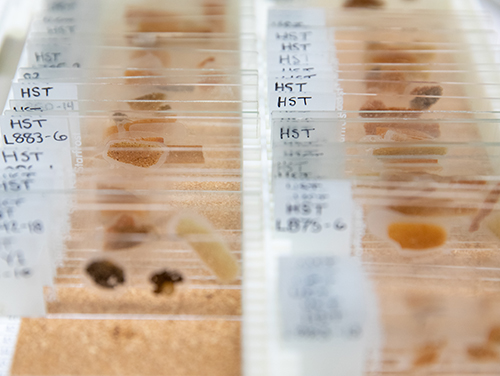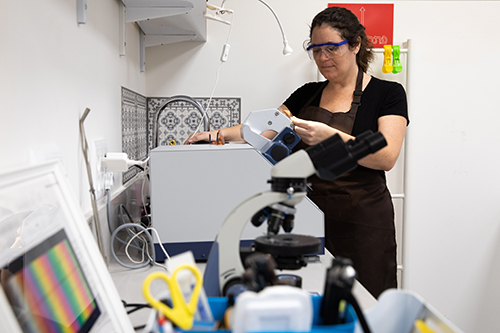The Ceramic Petrography Laboratory
For additional information
Dr. Paula Waiman-Barak
Director of the Lab and the Editor for Petrography at The Levantine Ceramics Project
Analytical Approach and Data Sharing Policy
Our research emphasizes the importance of a robust ceramic dataset obtained through a large sample size. We aim to broaden our analytical scope to include geological raw materials and archaeological sediments, such as mudbricks and clay installations. This comprehensive approach will provide invaluable insights into production techniques, sourcing strategies, and broader environmental contexts.
The lab regularly collaborates with the Levantine Ceramics Project (LCP). The LCP initiated by Prof. Andrea Berlin of Boston University is an open-access, interactive website that facilitates sharing archaeological ceramics information to researchers' global community. The LCP encourages the free flow and access to information and archaeological data. As a result, members of the Ceramic Petrography Lab become ambassadors connected to a range of projects while also contributing to the availability of new and essential data.
With over 75,000 page views a year, the LCP is a growing data source dedicated to gathering thousands of high-quality photomicrographs of petrographic thin sections.
Petrography

Fourier-Transform Infrared (FTIR) Spectroscopy

XRD and SEM-EDS
Recommended Analytical Protocol
Geological Samples

Pottery and Archaeological Sediments

Academic Collaborations and Pricing
- Ceramic or sediment thin section: 430 NIS
- Infra-red sample: 300 NIS
Prepayment is required. Credit cards are accepted.
Tests in external labs, such as XRD and SEM-EDS, are priced according to the external lab's rates.
A minimum order of 30 samples is required.
The number of samples will be determined according to the research question and budget.
Recommended Samples Size
|
Method |
Sample Size |
|
Petrography |
2*4 cm |
|
XRD |
2*2 cm |
|
SEM-ESD |
1*1 cm |
|
FTIR |
1*1 cm |
Visiting Program
We invite scholars and students to participate in a month-long intensive program at our Ceramic Petrography Laboratory for a fee of $1,250.
This program offers hands-on training in the fundamental techniques and methodologies employed in our lab, including ceramic petrography, FTIR spectroscopy, and other advanced analytical methods. Participants will have the opportunity to work with our state-of-the-art equipment and reference collections. The cost includes all training sessions and materials required for the program. Additionally, researchers are encouraged to bring their own assemblages to study, with a limit of 20 samples for the duration of the program.
Participants should have attained the knowledge and practical skills required to study and publish archaeological ceramics or the relevant archaeological background for the required research. Learning outcomes include an appreciation of the role of ceramic analysis in archaeology and specific skills in interpreting ceramics in thin sections.
Join us to enhance your skills and gain valuable insights into the study of ancient ceramics and archaeological sediments.
Lab Resources and Facilities
- Wet lab
- Reference collections of ceramics in thin sections
- Reference collections of rock and sediments in thin sections
- Reference collections of ceramic and geological samples
- Polarizing microscopes (3) and a zoom microscope equipped with a digital camera
- Thermo Scientific Nicolet iS5 FT-IR Spectrometer
- Dino-lite
- Small furnace for firing experiments
- Small drying oven
- Ecomet® 30 Twin Grinder-Polisher
- PetroThin® Thin Sectioning System
- Low-speed saws with a diamond blade
- Pottery wheel
- Ultrasonic Sonicator Bath


